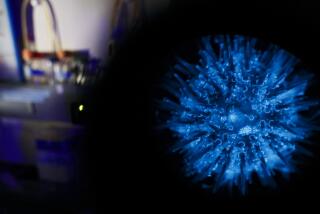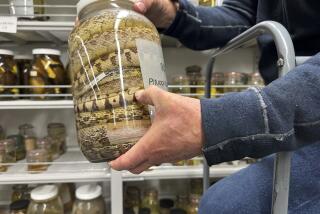A Library of Sea Dwellers : Scripps Collection of 3 Million Fish Provides Resource for Research Into Scientific Puzzles
SAN DIEGO — Like ocean-grown pickles, they lie packed on end in jars, eyes peering sightlessly into the murky rows of shelves cataloguing decades of expeditions throughout the world’s oceans.
These thousands of glass coffins enclose the Scripps Institution of Oceanography’s collection of “once-living” fish.
From lowly eels to the most recent celebrity addition--a fish that lives around deep-ocean, hot-water vents--these sea dwellers read as well as a whole library of books to ichthyologists. These are scientists involved in a branch of biology known as systematics. They trace evolution and solve other scientific puzzles by analyzing the fishes’ anatomy and carving out their innards.
“You can really think of a collection like this as an enormous research library, with one sort of major difference, which is that books will eventually go out of date,” said Richard H. Rosenblatt, professor of marine biology at Scripps.
Unlike books, these specimens also require forceps, scalpel and a practiced eye to read, and they aren’t easy to come by.
“You have to have reference material, and you can’t go out (to sea) every time you want to study a group of fishes and start gathering them up,” Rosenblatt said.
For the last two decades, he has presided over a collection of fish preserved in isopropyl alcohol. They range from tiny larvae to stony-looking bottom dwellers to sleek sharks (sliced on the diagonal to fit into big rectangular bins).
It now contains an estimated 3 million specimens, representing more than 4,000 species, most of them from the eastern Pacific Ocean.
Despite its size, it is not among the biggest or the most comprehensive fish collections in the United States. Those distinctions belong to holdings at such institutions as the National Museum of Natural History in Washington, the California Academy of Sciences in San Francisco and the Academy of Natural Sciences of Philadelphia.
But what the Scripps assemblage lacks in size, it makes up for in specialization, Rosenblatt said. It concentrates on eastern Pacific coastal fishes from Alaska to Chile and deep- and open-ocean fishes worldwide.
A 1976 survey of fish collections in the United States, published in the scientific journal Copeia, rated the Scripps collection at the top of specialized fish collections in the nation, noted Bill Eschmeyer, senior curator of the San Francisco collection.
Rosenblatt is proud of the Scripps menagerie’s unusual and, in some cases, unique specimens.
“The worst insult you can make to a systematist is to call him a postage-stamp collector. On the other hand, I think that a good curator has got to have some of that in him,” he said. “You just can’t help feeling a certain amount of satisfaction that you’ve got something that no one else has.”
The collection’s most-viewed rare fish is its coelacanth, a 3-foot-long primitive fish that was thought to have died out millions of years ago until one was caught off South Africa in 1938. It is on display for visitors to the Scripps Aquarium.
Scripps has an edge in collecting unique, deep-sea fish because even when its research ships aren’t on a fish-collecting expedition, the regular technicians know to freeze for Rosenblatt any fish dragged up inadvertently by geologists’ dredges.
This is important because the oceans are so big and the research efforts so small by comparison.
When an unusual fish does come in, Rosenblatt and colleagues get the ichthyological treat of “describing” the fish and comparing it to close relatives--in jars at Scripps or in other collections--to see whether the fish is unique. Color, shape, “things you can count” (such as thin bones in the fins) and size go into that determination, Rosenblatt said. If the fish proves unique, the person describing it gets to name it.
For instance, there’s Thermarces cerberus, a small fish described and named by Rosenblatt and Daniel M. Cohen of the Los Angeles County Museum of Natural History. It was found swimming in 1981 in the sulfur-rich waters around a hot-water vent in the ocean floor off central Mexico. Hence, its name: “Therm” to denote temperature. “Arces” refers to a fish group. And “cerberus,” after the dog that guarded the gates to hell in Greek mythology.
In a locked cabinet, the Scripps collection holds the “type specimen” for that species--the single fish used worldwide as the standard against which all other fish suspected of being that species are measured. All told, Scripps has about 100 type specimens for fish species, Rosenblatt said.
Time Series Crucial
Why is it important to identify fish so definitively and to save them for future study?
Rosenblatt and other systematists answer with a mixture of history, science, practicality and simple curiosity.
“There’s really an infinity of information in these fishes. Also, they’re unique in that they represent what a population was like at a given time at a given place. And it’ll never be like that again exactly. So time series are really important,” Rosenblatt said.
Samples of freshwater fish sometimes represent the only remainder of fish populations that civilization has made extinct, he noted. European fish collections contain fish going back to the heyday of European sailing ships.
Rosenblatt noted that when people were worried in the 1970s about mercury contamination in fish, it was the National Museum’s fish collection that calmed the fears. An ichthyologist tested fish collected in the 1800s and found the mercury levels hadn’t changed substantially, Rosenblatt said.
Questions about evolution and even about changes in the Earth’s geography can also be answered.
Victor Springer, curator of the fish division at the National Museum, thinks his studies of similarities between fishes around the South Pacific Islands of Rotuma and nearby Fiji will help experts in plate tectonics--the movement of plates of the Earth’s crust over millions of years.
Rotuma and Fiji sit in the middle of a volcanic island arc north of New Zealand, from the Solomon Islands on the west to the Samoan Islands on the east. That is an area where a continental Indo-Australian plate and oceanic Pacific plate are slowly grinding into each other.
“No one’s done any studies on the foundation of Rotuma,” Springer said. “They know it’s volcanic, but it’s so close to the edge (of the plates) . . . that no one has been sure where it originated.”
“When I went out and collected fishes in Fiji and Rotuma, I found that the fishes in Rotuma were related to the fishes in Samoa more than they were to the fishes in Fiji,” he said. Springer believes this shows that the Pacific plate, not its continental neighbor, spawned Rotuma. His study is scheduled to be published in September.
As Rosenblatt walked down the 80-foot aisle that slices the Scripps collection in half, he stopped at the angler fish, a group whose members lure prey with a fishing pole-like apparatus on their heads.
Key to Human Tissue Grafting?
Often, scientists find a male fused to the female, providing a sperm source in return for nourishment. For human organ-transplant surgery, where the biggest problem is that the recipient’s immune system attacks the transplanted tissue, such a parasitical union has important implications, Rosenblatt said.
“That’s an allograft between individuals. And it takes--without completely destroying the immune system,” he said. “So if you could figure out how these fish were doing that, you could have a tissue graft that would not be rejected. It would be wonderful.”
On the other hand, the most limiting factor of ocean research gets in the way of that scenario. It’s doubtful anyone could collect enough angler fish to mount such a project, Rosenblatt said.
“You can’t go out and get one of these whenever you want it, because the ocean is so huge and our nets are so small. It would just be totally impractical to say, ‘I’m going to mount a biochemical project to look at this angler fish,’ ” he said.
The Scripps fish collection began in earnest in 1944, when Carl L. Hubbs moved there from the University of Michigan. Hubbs established the coding and classification system still in use. When Rosenblatt took over the collection in 1958, Hubbs had built it to 2,500 species and 1 million specimens.
Currently, many volumes of paper-and-pen records are being transferred onto computer. This eventually could be linked with others throughout the country, in effect melding the collections into one huge resource where fish researchers could easily find where specimens they need are kept.
But the flesh and bones of the collection still will be the fish themselves.
“This is one reason you’ve got these specimens here,” Rosenblatt said, “and why we keep them here and don’t throw them out.”






